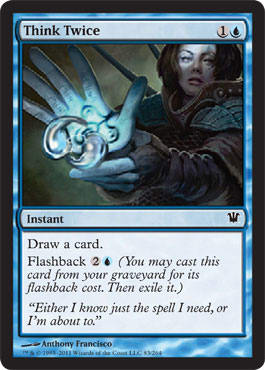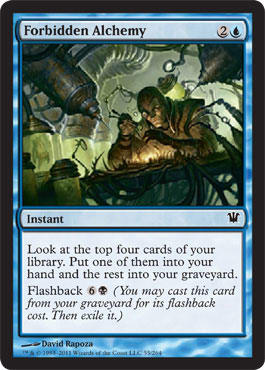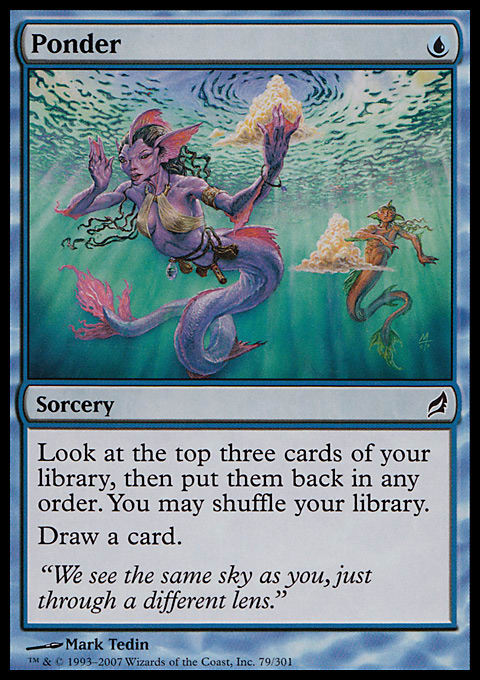I want to talk about what is a very popular card in Standard . . . and why I think it’s overrated. Let’s take a look at the card in question:
I spoke last week about the overall cost of drawing cards, and I feel that this card is a great example of the problems that causes. I feel that, in general, Think Twice is overplayed. It’s not a bad card, but like all cards, it has things that it is good at and things that it is not good at, and, as a deck-builder, you should be trying to have your cards accomplish things that they are good at. Let’s take a look at this card in depth—both its strengths and weaknesses.
Thinking Once
Think Twice is a very simple card. You pay 5 mana for two cards, you can do so at instant speed, and you can split it up into two payments. Its strengths are very simple to grasp: It nets you a card, it is an instant, and there is a decent amount of flexibility in the way you cast it. Thus, it is a viable option if drawing a card is a desirable effect for your deck.
But there is an element to consider that I feel most people don’t look at with Think Twice: efficiency. Many players think about mana efficiency with respect to other types of cards (particularly creatures) but do not really consider it when it comes to card-drawing. This has never really made sense to me. Even so, let’s compare Think Twice to some basic pieces of card-drawing—some of which have seen a lot of tournament play, and some of which haven’t.
We’ll do this by comparing how much mana is spent for each card netted. If there are other benefits as well, they will be mentioned. Here’s an example:
Ancestral Recall: +2 cards for 1 mana = 0.5 mana per card.
So, how does Think Twice do? Well, you pay 5 mana for a net gain of only one card—for a whopping 5-mana-per-card ratio! Ancestral Recall is ten times as mana-efficient. But, of course, comparing Think Twice to Ancestral Recall is a bit unfair, so let’s see how Think Twice fares against some other, more normal, competition.
Group 1 – Basic Card-Drawing
Divination: 3 mana per card
Tidings: 1.67 mana per card
Jace's Ingenuity: 2.5 mana per card
Harmonize: 2 mana per card
Opportunity: 2 mana per card; instant speed
Inspiration: 4 mana per card; instant speed
Deep Analysis: 2 mana and 1 life per card (combined) or 1 mana and 1.5 life per card (flashback only)
Group 2 – Complications Arise
Compulsive Research /Thirst for Knowledge: 3 mana per card; card-selection
There is obviously added value in being able to filter bad cards out of your hand in exchange for good cards.
Fact or Fiction: Ranges depending on split, but often 2 mana per card; added value of getting what you want from the top five
Fact or Fiction is another weird card that presents you with the opportunity to choose what you want out of the top five cards. More often than not, it will net one or two cards, but it can get you more or fewer depending on the situation.
Ancestral Vision: 0.5 mana per card; wait four turns
Accumulated Knowledge: Average 1.11 mana per card if all four are cast; 2.5 mana per card if paired with Intuition and cast once; 1.17 mana per card if cast twice while paired with Intuition; combo is instant-speed
If you look at this group of cards, you should see a pattern developing. The vast majority of the “good” card-drawers do not require you to pay more than 2 mana per card you net. Some cards provide the added benefit of giving you card-selection in addition to pure card advantage.
Does this value make sense to you? It should—2 mana is the value of a random card. Thus, if you are paying more, you are overpaying for that effect. Many of the stronger card-drawers actually cost significantly less or give you some bonus for your 2-mana-per-card investment. Let’s look at those:
- Accumulated Knowledge has an incredibly low mana-per-card cost when combined with Intuition (which is how it was used). It was also an engine that was instant-speed. This made Intuition with Accumulated Knowledge a go-to draw engine for a very long period of time.
- Fact or Fiction can net you more card advantage, but is also instant-speed while giving you card-selection from the cards in the top five.
- Ancestral Vision is just mind-numbingly mana efficient . . . even if you do have to wait for it.
- Deep Analysis was frequently just flashed back—and not cast—which means the value you get out of it is absolutely tremendous. However, even if you did cast the front side, the effect was still very reasonable, especially across two payments.
- Tidings is a pretty efficient, albeit expensive, draw spell. The efficiency means that it has seen periodic play, but the expense definitely hurts this card.
So, what do Compulsive Research and Thirst for Knowledge show us? They show us the value of card-selection. While Compulsive Research and Thirst for Knowledge can only result in +1 total cards they, allow you to select which cards out of your hand and the three you draw you keep. If this discard is viewed as a non-cost, Compulsive Research and Thirst for Knowledge come in at a cool, efficient 1.5 mana per card, which is below our 2-mana-per-card threshold.
However, this discarding is many times not costless, so what is the value of card-selection? Well, it’s obvious that the ability to at least see three cards deep is worth at least 1 mana (Compulsive Research and Thirst are 1 mana more than the baseline efficiency), but given the strength of these two cards, it is probably worth more. Information is valuable.
So, remember what I said earlier? Looking at the historical card-drawers should put Think Twice into perspective. Think Twice is 5 mana for an extra card! That’s way over baseline and hugely inefficient. You are paying more than double what you should be for that effect.
Would you pay ![]()
![]()
![]() for Grizzly Bears? Would you pay
for Grizzly Bears? Would you pay ![]()
![]()
![]() for Incinerate? Would you pay
for Incinerate? Would you pay ![]()
![]()
![]() for Noble Hierarch? Would you pay
for Noble Hierarch? Would you pay ![]()
![]()
![]()
![]()
![]() for Day of Judgment?
for Day of Judgment?
You are overpaying by a ton for that extra card when you use Think Twice.
Thinking Twice
So, why is Think Twice good? Well, let’s look at the first time this card was Standard-legal.
"Dralnu du Louvre by Guillaume Wafo-Tapa"
- Creatures (5)
- 1 Skeletal Vampire
- 1 Dralnu, Lich Lord
- 3 Teferi, Mage of Zhalfir
- Spells (31)
- 1 Commandeer
- 1 Last Gasp
- 1 Seize the Soul
- 1 Sudden Death
- 3 Spell Snare
- 4 Mystical Teachings
- 4 Remand
- 4 Repeal
- 4 Rewind
- 4 Rune Snag
- 4 Think Twice
- Lands (24)
- 2 Dreadship Reef
- 3 Dimir Aqueduct
- 4 Desert
- 4 Underground River
- 4 Watery Grave
- 7 Snow-Covered Island
This was Ravnica/Time Spiral Standard, so Compulsive Research was legal and the draw spell of choice for many decks. Why, then, was Think Twice the cornerstone for a year in various iterations of Dralnu? There are two reasons.
Firstly, Think Twice is an instant. Look at the way the deck is designed—everything is at instant-speed. This is a very powerful advantage to have. Dralnu needed a little bit of midgame card advantage before it got to the end-game of putting a Dralnu on the table. If you look at the legal instant-speed options, Think Twice is the best of a very thin bunch. It’s important for them all to be instants—that allows the Dralnu player to best make use of his limited mana. You should take note of the fact that Dralnu gets away with being a long-game control deck running only twenty-four lands! Thus, the instant-ness of Think Twice was absolutely crucial to the role it played in this deck.
The second main reason is that Dralnu doesn’t need Think Twice for actual card advantage. It needs Think Twice to shrink its deck a little to make sure it survives the midgame. So, where does Dralnu’s real card advantage come from? The combination of Mystical Teachings and Dralnu, Lich Lord. The singleton copy of Dralnu, Lich Lord generates so much card advantage by giving all of Dralnu’s spells flashback. Mystical Teachings is solid at getting the tools that you need while also tutoring up Dralnu, ensuring that you never actually run out of cards. Thus, the role of pure card advantage is covered through other means. Think Twice is strictly supplementary.
It’s worth it to note that Dralnu was the only major archetype while Time Spiral was Standard-legal to make use of Think Twice. Everyone else cast Compulsive Research or Ancestral Vision, a fact that should surprise no one. Both of those cards are simply much more mana-efficient. The main quality that made Think Twice attractive to Dralnu was its card type: instant. This synergized well with the rest of the deck and had a large, positive impact on Dralnu’s own mana usage, allowing the deck to spend its mana in a very efficient manner.
Thinking Today
Looking at today’s card pool, there really is a huge lack of any decent card-drawing. Vivisection is probably the most efficient draw spell, but it requires creatures. I feel that this is part of the reason people are playing Think Twice, but the fact that you can doesn’t mean that you should. Even when it was used optimally, Think Twice was just to shrink the deck and provide a little bit of incremental advantage.
People have been talking about this card as a Mystical Teachings analogue as well:
Let’s talk about that comparison. Alchemy is a reasonable analogue to Mystical Teachings, but only because it interacts with sorceries, creatures, planeswalkers, enchantments, artifacts, and lands. The ability of Alchemy to smooth your draws, find you what you need, and provide card advantage in the form of card-selection is quite potent. All in all, it approaches the problem in a similar way to Mystical Teachings: control the game by having the right spell at the right time.
But now, it’s time for the bombshell. Mystical Teachings had Dralnu, Lich Lord waiting at the end. What does Forbidden Alchemy have? The answer is: not too much.
Dralnu, Lich Lord was a devastating piece of card advantage that a Mystical Teachings deck could abuse. Dralnu, Lich Lord was the way the deck generated card advantage, and Dralnu, Lich Lord was the light at the end of the tunnel. Frequently while playing the deck, all you were trying to do was maneuver into a position in which you could cast a Dralnu at the end of the opponent’s turn. If you successfully tabled a Dralnu protected by a Teferi, the game was pretty much always over at that point. The raw amount of card advantage you would generate over the rest of the game was almost always insurmountable.
Forbidden Alchemy doesn’t have that ability. Forbidden Alchemy, however, has the ability to draw on any card to be the right card for the right situation. Whether it’s a planeswalker like Liliana of the Veil, a sorcery like Day of Judgment, or even a lowly land, Forbidden Alchemy can find it for you. Thus, from a deck-design standpoint, complementing this ability is very important. If your deck is based on having the right spell at the right time, you need to have two things. The first is the ability to find your big spells. The second is having flexible, powerful spells like Day of Judgment. There is no shortage of relatively powerful, flexible spells in today’s Standard format, and there is one card that is also pretty good at complementing the general plan of finding specific spells:
The contrast between Ponder and Think Twice is huge. It is not only a contrast in efficiency, but also a contrast in purpose. The purpose of Ponder is not to net cards, but to find the correct card at the proper moment. As I’ve already been through before, Think Twice is pretty terrible at netting cards, and if that’s what you want from it, you should probably be looking elsewhere. However, Think Twice is reasonable at smoothing out draws, but so is Ponder, and I think Ponder is better at the job for the most part.
However, I can hear the counter-argument already:
But wait, you forgot about the interaction between Forbidden Alchemy and Think Twice!
I didn’t. Let’s take a look at that. Even if you bin a Think Twice with Alchemy, you are still paying 3 mana for an extra card. Granted, this comes from a source you don’t always have the ability to take advantage of, so that is a plus. Even so, this play is not horribly mana-efficient. I wouldn’t say it’s a bad play, but it is still above the baseline of what you really want to be paying for that extra card (2 mana). The fact that it comes from an otherwise unexploitable source does mitigate that cost, but it doesn’t make the interaction particularly strong.
The second part of this comes with the following question: How often do you cast Think Twice off Forbidden Alchemy? More often than not, you cast Think Twice off the draw, and thus you are paying the 5 mana cost for it as opposed to the 3. All in all, Think Twice is a pretty inefficient card-drawing spell even off Forbidden Alchemy, and it’s even worse when you draw it.
Conclusion
Card-drawing is not an effect to be thrown around willy-nilly, and it is only a single method to obtaining card advantage. As the original Dralnu list shows, there are many different ways of approaching the concept of card advantage, and understanding the purpose of your cards and their efficiency of execution is a critical step to strong deck-building. Think Twice is a recent example of a card with which I feel that a lot of deck-builders have gone awry. In order to have the strongest deck possible, you must have the right card for each job.
In the end, this is all deck-building is. Think about what each card is doing, and ask yourself: Is this really the best card for the job?
Chingsung Chang
Conelead most everywhere and on MTGO
Khan32k5 at gmail dot com


























